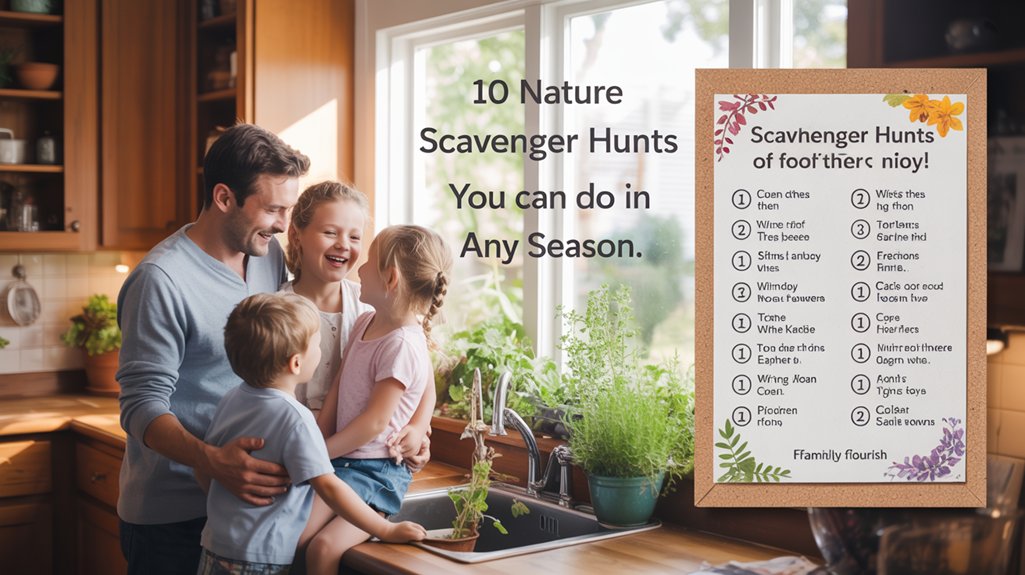You can explore nature year-round through ten seasonal scavenger hunts: search for rainbow colors in spring blooms and autumn leaves, collect texture samples from bark and stones, document seasonal sounds from bird calls to insect choruses, identify geometric shapes in spider webs and pinecones, detect weather signs like shadow patterns and closed cones, compare sizes from microscopic lichen to towering trees, track wildlife through prints and scat, engage multiple senses with scents and textures, practice counting species and leaf variations, and photograph natural patterns while respecting habitats. These activities develop scientific observation skills while nurturing environmental stewardship across changing seasons.
Key Takeaways
- Rainbow Color Hunt adapts seasonally: spring yellows and purples, summer reds and blues, autumn golds, winter whites and evergreens.
- Texture Collection engages all senses by discovering smooth stones, rough bark, bumpy pinecones, and soft moss year-round.
- Seasonal Sounds Safari documents distinctive acoustic signatures from spring bird migrations to winter's sparse soundscapes using field journals.
- Shape Spotting identifies circles, triangles, spirals, and hexagons in tree rings, spider webs, and pine cone scales across seasons.
- ABC Nature Challenge customizes lists matching local ecosystems and current seasons while prioritizing observation over collection for habitat protection.
Rainbow Color Hunt: Find Nature's Palette in Every Season
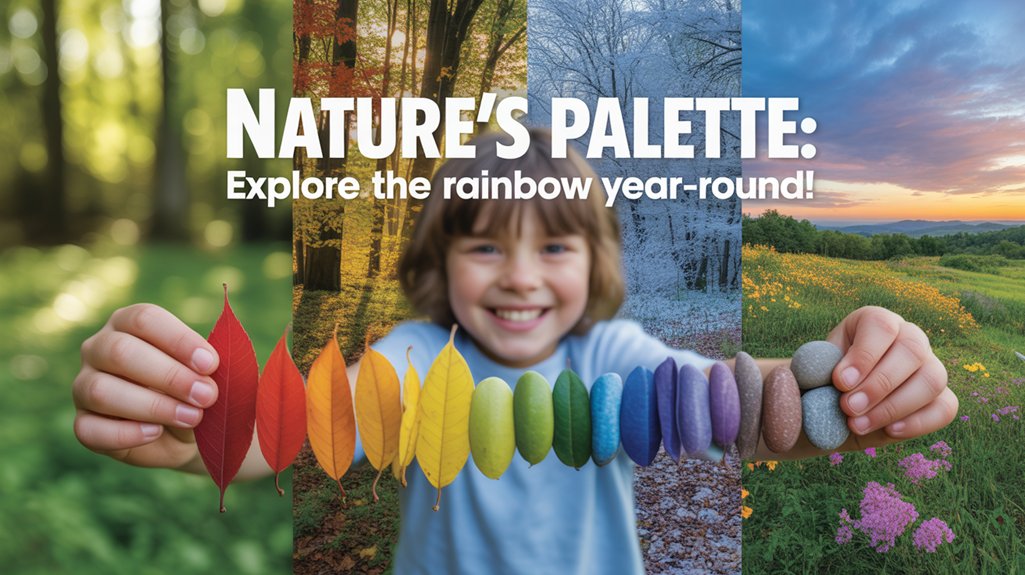
How does nature organize its visual symphony across the changing seasons? You'll discover that colorful flora follows predictable patterns year-round, offering endless opportunities to engage others in meaningful outdoor exploration.
Begin your rainbow hunt by identifying seasonal hues. Spring brings yellows and purples through dandelions and crocuses. Summer explodes with reds, oranges, and blues from wildflowers and berries. Autumn alters leaves into amber, crimson, and gold displays. Winter reveals whites, browns, and evergreen foliage that many overlook.
Each season paints its own palette—from spring's vibrant yellows and purples to winter's subtle whites and enduring greens.
Create collection cards featuring color swatches for participants to match with natural objects. Encourage photography instead of picking to preserve ecosystems. Challenge groups to find multiple items per color, documenting patterns in plant pigmentation.
This activity teaches valuable lessons about photosynthesis, anthocyanins, and carotenoids while promoting environmental stewardship.
You're helping others recognize biodiversity, understand phenology, and develop observation skills that change casual nature walks into scientific investigations benefiting conservation efforts.
Texture Collection: Smooth, Rough, Bumpy, and Soft Natural Objects
While color captures immediate attention during nature exploration, tactile properties reveal equally important information about how organisms adapt to their environments.
You'll guide participants to discover smooth stones polished by water erosion, rough bark that protects trees from herbivores and temperature extremes, bumpy pinecones with scales designed for seed dispersal, and soft moss that indicates moisture levels and air quality.
This sensory approach helps individuals with visual impairments fully engage with outdoor spaces while teaching everyone about functional morphology. You're creating opportunities for learners to understand that texture isn't merely aesthetic—it's evolutionary strategy made tangible.
Establish collection guidelines that prioritize conservation: photograph attached materials, gather only fallen items, and return living specimens after observation.
You'll teach participants to document findings through texture rubbings, descriptive journals, and comparative analysis. This method develops scientific observation skills while nurturing respect for ecological systems that depend on leaving natural materials undisturbed.
These hands-on outdoor experiences support healthy, active living by encouraging children to overcome obstacles like screen time and sedentary habits while connecting with their natural environment.
Seasonal Sounds Safari: Listen for Wildlife and Weather
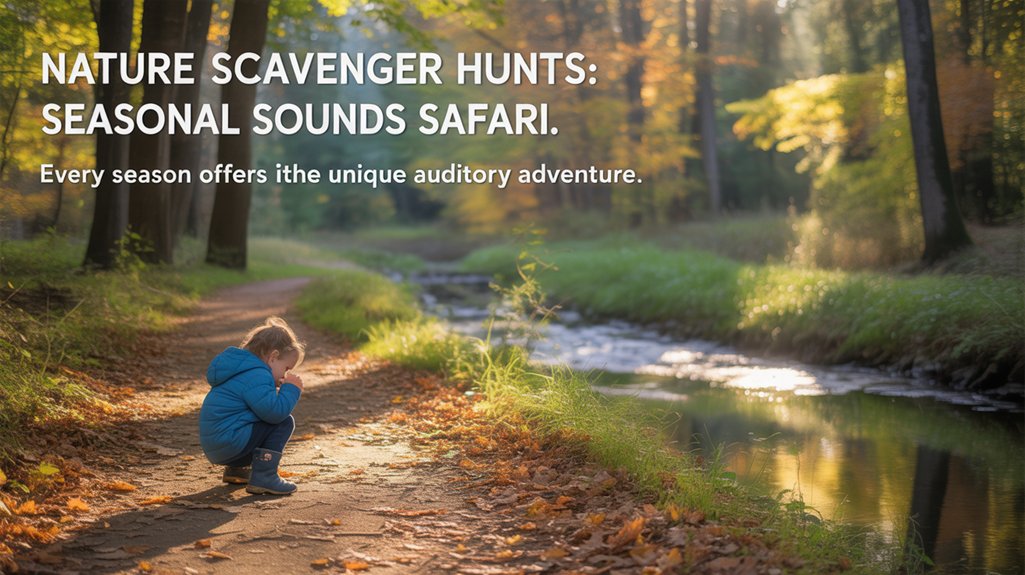
You'll develop stronger naturalist skills when you systematically document the sounds you encounter during different seasons, times of day, and weather conditions.
Start by recording your observations in a field journal, noting which bird calls dominate spring mornings versus autumn evenings, or how insect choruses change from June to September.
Focus your listening efforts during dawn and dusk—the peak activity periods for most wildlife—when you're most likely to hear territorial songs, hunting calls, and the subtle shifts in animal behavior that signal seasonal changes.
Recording Your Sound Discoveries
Documenting the sounds you encounter alters a simple listening walk into a valuable scientific record that captures the acoustic signature of each season.
You'll create meaningful data through sound mapping—sketching your route and marking where specific sounds occurred with descriptive labels.
Audio journaling strengthens this practice by recording observations immediately: note the time, weather conditions, and dominant frequencies you're hearing.
Consider using smartphone apps designed for birdsong identification or basic audio recording to capture actual soundscapes for community science projects.
These methods help conservation efforts by tracking species presence, migration patterns, and habitat health over time.
When you share your findings with local nature centers or citizen science platforms, you're contributing to biodiversity monitoring that benefits entire ecosystems and future generations.
Seasonal Audio Patterns
Each season broadcasts its own distinctive acoustic signature, shaped by temperature, precipitation, and the behavioral cycles of wildlife.
You'll notice spring's dawn chorus intensifies as migratory birds establish territories, while summer buzzes with insect activity during peak daylight hours.
Autumn brings migration calls and rustling as animals forage frantically before winter.
Winter's sparse auditory landscapes reveal sounds often masked during busier seasons—ice cracking, wind patterns, and hardy resident species.
Understanding these seasonal rhythms helps you guide others in appreciating nature's cyclical patterns.
Document how local soundscapes shift monthly, noting species arrivals and departures.
This knowledge enables you to design meaningful outdoor experiences that connect participants with conservation needs.
Dawn and Dusk Listening
Why do the hours surrounding sunrise and sunset consistently deliver the richest acoustic experiences in nature? These changing periods trigger dramatic behavioral shifts in wildlife, creating what scientists call the dawn chorus and dusk symphony. You'll observe temperature inversions that amplify sound transmission, while reduced wind conditions minimize acoustic interference.
| Time Period | Primary Vocalizers | Conservation Value |
|---|---|---|
| Dawn | Songbirds, amphibians | Population monitoring |
| Dusk | Owls, bats, insects | Biodiversity assessment |
| Both | Coyotes, deer | Habitat health indicators |
Document species-specific calling patterns to contribute citizen science data. You're supporting critical baseline studies when you record calling frequency, duration, and environmental conditions. This acoustic monitoring reveals ecosystem health, seasonal breeding cycles, and climate change impacts—transforming your listening sessions into meaningful conservation action.
Shape Spotting: Circles, Triangles, and Patterns in Nature
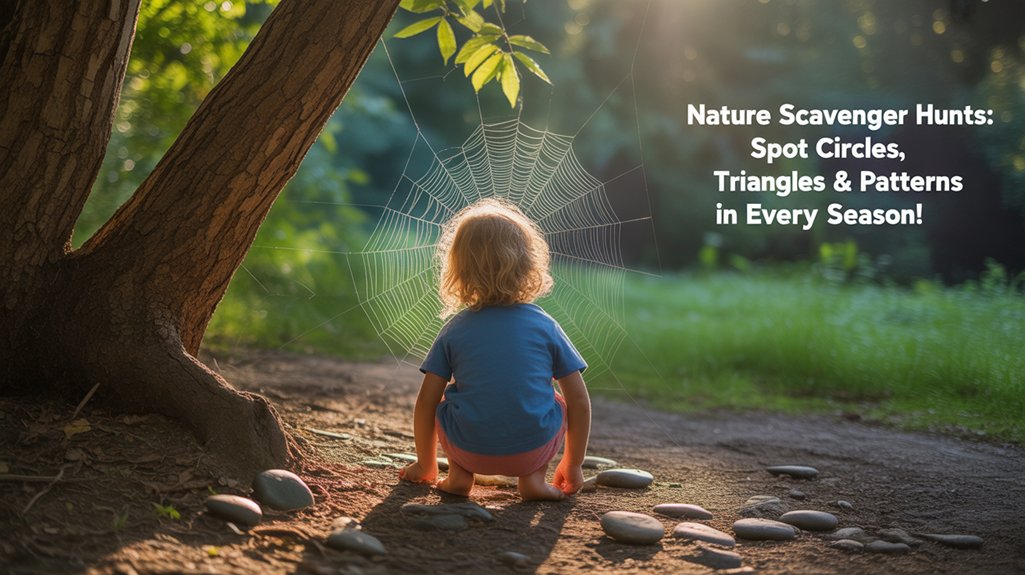
Nature operates as a master geometer, arranging its components into recognizable shapes that serve specific survival functions. When you guide others through shape-spotting activities, you'll help them discover mathematics embedded in ecosystems.
Circle identification reveals nature's efficiency—from tree rings recording growth to spider webs maximizing capture area. Triangle tracing appears in evergreen branches distributing weight and pine cone scales protecting seeds.
Nature's geometry solves practical problems: circles conserve energy in growth rings and webs, while triangles distribute structural loads in branches and cones.
Engage participants by searching for:
- Spirals in unfurling ferns, sunflower seed arrangements, and snail shells following Fibonacci sequences
- Hexagons in honeycomb cells, snowflake crystals, and basalt column formations
- Symmetry patterns in leaf venation, butterfly wings, and flower petals attracting pollinators
- Fractals repeating across scales in tree branching, coastlines, and cauliflower florets
- Tessellations in turtle shells, pineapple surfaces, and dried mud cracks
This exercise sharpens observational skills while demonstrating how geometric principles govern resource distribution, structural integrity, and reproductive success. These activities support children's learning and emotional needs by connecting mathematical concepts to their direct experiences in nature.
You're nurturing scientific literacy that strengthens environmental stewardship.
Weather Detective Hunt: Signs of Sun, Rain, Wind, and Temperature
Before technological instruments measured atmospheric conditions, organisms evolved sophisticated mechanisms to detect and respond to weather changes—adaptations you can teach others to recognize and interpret.
Guide participants to observe sunny signals: lizards basking on exposed rocks, flowers opening fully, and increased insect activity during stable high-pressure systems. Document shadow lengths and directions as solar position indicators.
For rainy indicators, search for closed pine cones (scales contract when moisture increases), curled leaves protecting stomata, and low-flying insects responding to atmospheric pressure changes. Spider webs heavy with condensation forecast approaching precipitation.
Wind evidence includes bent grass patterns, asymmetrical tree growth, and directional seed dispersal.
Temperature clues manifest through dew formation on cool surfaces, thermal refuge selection by wildlife, and visible breath condensation.
This detective work builds scientific observation skills while nurturing appreciation for organisms' environmental sensitivity. Participants develop weather prediction abilities useful for planning outdoor service activities and understanding climate impacts on ecosystems they'll help protect.
ABC Nature Challenge: Find Items for Every Letter
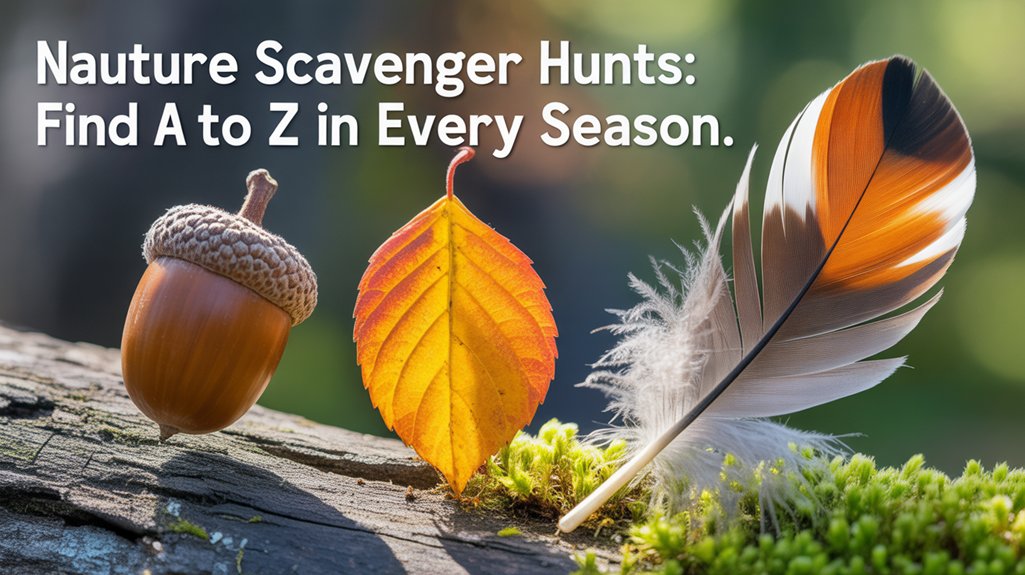
The ABC Nature Challenge changes alphabet learning into an outdoor exploration by tasking you to find natural items representing each letter from A to Z.
You'll need to create a customized list that matches your local ecosystem and current season, since oak leaves won't appear in winter and desert cacti won't exist in temperate forests.
Strategic planning guarantees success: prepare alternative items for difficult letters like X and Q, adjust expectations based on whether you're hunting in spring's abundance or winter's scarcity, and always prioritize observation over collection to protect natural habitats.
Creating Your ABC List
Alphabet-based scavenger hunts convert ordinary nature walks into systematic observation exercises that sharpen identification skills across diverse taxonomic groups.
When designing your nature alphabet, select ABC categories that reflect local biodiversity while accommodating seasonal availability. You'll create meaningful learning experiences by balancing common specimens with challenging finds.
Structure your list using these principles:
- Taxonomic diversity: Include plants, animals, fungi, and geological features
- Sensory engagement: Incorporate items identified by texture, sound, or scent
- Conservation awareness: Feature native species requiring habitat protection
- Accessibility levels: Mix obvious discoveries with observation-dependent finds
- Documentation methods: Specify photography, sketching, or written descriptions
Adapt categories for different skill levels, ensuring participants develop ecological literacy while minimizing environmental disturbance through observation-only protocols.
Seasonal Adaptations and Tips
Since ecological communities change dramatically throughout the year, you'll need to adjust your ABC nature challenges to match what's observable during each season.
Spring scavenger hunts can focus on emerging buds and migrating birds, while summer offers abundant insects and flowering plants.
Autumn provides opportunities to identify seeds, nuts, and changing leaf colors—perfect for teaching about nature survival strategies as organisms prepare for winter.
Winter challenges require creativity: search for evergreen needles, animal tracks in snow, or persistent seed pods.
These seasonal adaptations in your lists help participants understand ecological cycles and species' survival mechanisms.
When leading groups, emphasize how organisms adapt to seasonal changes, nurturing appreciation for nature's resilience.
Always remind participants to observe without disturbing wildlife or removing plant specimens from protected areas.
Size Comparison Hunt: Tiny Treasures to Giant Discoveries
Exploring nature through size comparisons alters ordinary observations into extraordinary learning moments about scale, proportion, and ecological relationships.
You'll guide participants to discover how size variations reveal nature's ingenious adaptations and interconnected systems.
Challenge seekers to find items representing different scales:
- Microscopic indicators: Examine lichen patterns, moss structures, or insect eggs that reveal intricate miniature ecosystems
- Handheld specimens: Collect seeds, pinecones, or leaves demonstrating natural proportions within species variation
- Medium discoveries: Locate rocks, branches, or fungi showing intermediate ecological roles
- Large features: Identify trees, boulders, or animal tracks representing established community members
- Landscape elements: Observe hills, waterways, or canopy layers illustrating ecosystem-wide patterns
This activity develops spatial reasoning while nurturing appreciation for biodiversity's full spectrum.
You're teaching participants that conservation requires protecting habitats supporting life at every scale—from soil microorganisms to apex species.
Each size category contributes essential ecological functions worth preserving.
Signs of Wildlife: Tracks, Nests, and Animal Evidence
Animals leave behind evidence of their presence even when they're not visible, altering your scavenger hunt into detective work.
You'll learn to identify tracks in mud or snow, locate nests and burrows in trees and underground, and recognize scat, feathers, and shed fur as valuable clues.
Each piece of evidence tells a story about which species inhabit your local ecosystem and how they use the landscape to survive.
Identifying Animal Tracks
When you examine the ground during a scavenger hunt, animal tracks offer some of the most accessible evidence of wildlife activity. Track identification improves your understanding of animal behavior while connecting participants to local ecosystems.
Focus on these key characteristics when analyzing tracks:
- Number of toes: Count visible toe impressions and note claw marks.
- Track pattern: Observe whether prints appear in pairs, alternating lines, or clusters.
- Size and depth: Measure dimensions and assess substrate penetration.
- Gait indicators: Identify walking, running, or hopping movement patterns.
- Habitat context: Consider surrounding vegetation and terrain features.
Document your findings through sketches or photographs, creating educational resources for future nature enthusiasts.
This practice strengthens observation skills while promoting environmental stewardship and wildlife appreciation within your community.
Discovering Nests and Burrows
Beyond ground-level tracks, wildlife leaves architectural evidence throughout forest canopies, grasslands, and underground networks.
You'll discover bird nests in tree branches, ranging from delicate hummingbird cups to bulky hawk platforms. Document nesting behaviors by observing construction materials—twigs, moss, or mud—which reveal species identity without disturbing inhabitants.
Burrow locations indicate mammal activity: rabbit warrens show multiple entrances, while fox dens feature single openings with scattered prey remains. Ground squirrels create mounded soil around entries, whereas voles leave runway systems through grass.
Never probe burrows, as this stresses wildlife and damages homes. Instead, photograph entrance dimensions and surrounding vegetation.
Share your findings with local wildlife organizations—your observations contribute to habitat conservation efforts and help communities understand ecosystem health in their region.
Finding Scat and Feathers
While tracks and burrows reveal where animals travel and shelter, scat identification and feathers provide direct evidence of species presence, diet, and health.
You'll discover remarkable insights by examining these often-overlooked treasures during your nature explorations.
When searching for animal evidence, focus on these key locations:
- Trail intersections where wildlife naturally converges
- Base of trees and fence posts where birds perch and preen
- Rocky outcrops that predators use as territorial markers
- Water sources where animals gather and leave droppings
- Open meadows after molting season for pristine feather types
Document your findings with photos and field notes.
You're contributing valuable citizen science data while teaching others about wildlife ecology, promoting environmental stewardship in your community.
Sensory Exploration: Smell, Touch, and Observe Different Elements
Engaging multiple senses changes a standard nature walk into a rich scientific investigation. You'll help participants develop observational skills while nurturing environmental stewardship through intentional smell exploration and touch sensations.
Guide learners to crush pine needles between fingers, releasing volatile compounds. Encourage them to feel bark textures, distinguishing smooth beech from rough oak. Document observations systematically using this framework:
| Sense | Natural Element | Scientific Observation |
|---|---|---|
| Smell | Crushed leaves | Identify aromatic compounds |
| Touch | Tree bark | Compare texture patterns |
| Sight | Lichen colors | Note biodiversity indicators |
| Sound | Rustling grasses | Detect wind patterns |
You're teaching participants to notice subtle environmental changes that indicate ecosystem health. When children describe sulfurous wetland odors or waxy leaf coatings, they're practicing descriptive language while connecting to conservation concepts. These multi-sensory experiences create lasting memories that inspire environmental advocacy and continued scientific curiosity.
Nature's Numbers: Count and Compare Natural Items
Mathematical thinking emerges naturally when you challenge participants to quantify the living world around them.
Counting critters and comparing colors alters observation into active scientific inquiry, helping learners develop both numerical literacy and ecological awareness.
Design counting activities that emphasize population patterns and biodiversity. Participants can document their findings to support citizen science initiatives and conservation efforts:
- Count different species within a defined area to understand habitat diversity
- Tally insects on flowering plants to observe pollinator activity patterns
- Compare leaf shapes and record variations within single tree species
- Enumerate bird calls heard during five-minute intervals at different locations
- Measure and compare dimensions of pinecones, acorns, or seed pods
These quantitative exercises strengthen analytical skills while nurturing deeper connections to ecosystems.
When you engage others in numerical nature exploration, you're cultivating both mathematical reasoning and environmental stewardship.
This dual-purpose approach serves communities by developing scientifically literate individuals who value biodiversity preservation.
Frequently Asked Questions
What Safety Precautions Should Children Take During Nature Scavenger Hunts?
You'll need to guarantee children wear appropriate safety gear including closed-toe shoes, long pants, and sun protection.
Teach them to take insect precautions by applying bug spray and checking for ticks afterward.
You should establish clear boundaries, require buddy systems, and emphasize the “look but don't touch” rule for unknown plants and animals.
Always carry first-aid supplies and guarantee children stay hydrated.
How Long Does a Typical Nature Scavenger Hunt Take to Complete?
A typical duration for your nature scavenger hunt ranges from 30 minutes to two hours, depending on your group's age and objectives.
You'll notice seasonal variations affect completion time—winter hunts often finish faster due to limited daylight and cold, while spring and summer allow extended exploration.
For educational programs serving youth, plan 45-60 minutes to maintain engagement while promoting environmental stewardship.
Always adapt your timeline to guarantee participants can observe nature mindfully and safely.
What Supplies or Equipment Do We Need to Bring Along?
Your scavenger hunt supplies should include a collection bag, field guide, and smartphone for photos.
Essential equipment varies by season—bring water, sunscreen, and insect repellent in summer; layers and hand warmers in winter.
You'll want a notebook to document findings and help others learn.
Consider adding magnifying glasses for detailed observation and binoculars for wildlife viewing.
Can Nature Scavenger Hunts Be Done in Urban Parks and Cities?
You'll find abundant treasures even in “concrete jungles”! Urban wildlife thrives in city parks, offering excellent scavenger hunt opportunities.
You can search for diverse park features like native trees, flowering plants, and bird species that've adapted to metropolitan environments. These accessible locations help you serve your community by promoting environmental awareness and connecting neighbors with nature.
Cities provide unique observation opportunities, from pollinators visiting urban gardens to migratory birds resting in green spaces during their journeys.
Are There Age-Appropriate Modifications for Toddlers or Elderly Participants?
You'll want to implement toddler adaptations like picture-based hunt cards, shorter distances, and sensory-focused activities such as touching tree bark or listening for birds.
For elderly considerations, you should create accessible routes with rest stations, use magnifying tools for detailed observation, and focus on seated activities like cloud identification.
Both modifications honor participants' capabilities while nurturing environmental stewardship.
You're ensuring everyone can meaningfully connect with nature regardless of physical limitations.
Conclusion
You've revealed nature's treasure chest—one that never closes, regardless of the season outside your door. These scavenger hunts change every outdoor space into a living classroom, where observation sharpens like a hawk's vision and curiosity blooms perennially. As you explore, you're not just collecting memories; you're cultivating environmental stewardship. Each discovery plants seeds of conservation in young minds. So grab your list, step outside, and let nature's endless lessons unfold beneath your feet, rain or shine.

